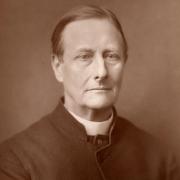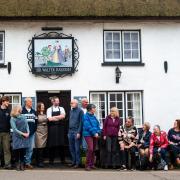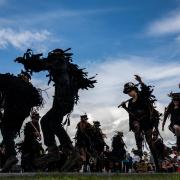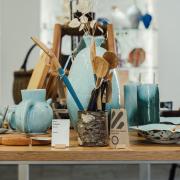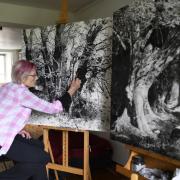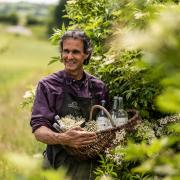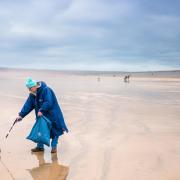Furniture restorer Kevin Chanot started making violins after discovering that his ancestors had been making them for almost 250 years and were renowned for their craft. Sue Cade visits his workshop near Exeter to find out more.
Delving into family history often throws up unexpected vestiges of skills and talent lost in the mists of time. Way back in my own family tree, for example, are East London silversmiths, although the silver is long gone.
But imagine knowing that you are related to some of the most renowned violin makers in the world. Just what might you do with that legacy if anything?

Kevin Chanot’s ancestors have been making violins for almost 250 years. But it took him a long time to decide to take up the mantle.
He grew up in Guildford in the 1960s and always had a love of cars and motorcycles, becoming an HGV mechanic before moving into factory work which involved working with wood and marble. His next foray was into furniture restoration.
‘I found an ideal job where I was pretty much left to get on with it. It seemed I had a natural aptitude and eventually I opened my own workshop in Farnham, where we were then living.’
Kevin’s wife’s work as a family lawyer brought them to Devon where he joined classical furniture specialist Brights of Nettlebed as a restorer before going solo once more, this time with a workshop in Budleigh Salterton. It was here that Kevin undertook his first violin repairs. ‘For me this was a pivotal moment - I realised I had an underlying yearning to make violins.’

He says he’s always been fascinated by his family history, which he has traced back to the 1780s when the Chanots of rural Alsace Lorraine were industriously combining agriculture and vineyards with a side-line activity, making violins.
‘Accounts I’ve read indicate that Joseph Chanot was the first violin maker in the family. Joseph’s son Georges then became a successful maker himself - he worked in the violin centre of the day, Paris, and travelled extensively cultivating an enviable expertise in the earliest Italian instruments.’
The British branch of the family was established when Joseph’s grandson, another Georges, moved to London to study under a French violin maker Charles Maucotel. Georges launched his own successful business in Wardour Street, where he remained for many decades. His sons, Joseph Anthony and George Adolphus emulated their father's work as a craftsman, as did Kevin’s great grandfather Frederick William who also became a well-known music publisher.
Then there came a lull in instrument making in the war years, partly down to the increasing popularity of recorded music. The last two Chanots working in the 20th century were predominantly repairers and dealers rather than violin makers, and they continued dealing in musical instruments until the 1970s.

Buoyed up by his success with restoring antique furniture which showed Kevin that he had the innate ability to work with wood, he felt ready to pursue his dream of reawakening the family trade and name synonymous with violin making.
But although he was filled with enthusiasm, he wasn’t certain how to go about it.
‘I started by looking up violin makers in the Yellow Pages! Then I came across a local violin maker who gave me masses of encouragement; he told me to feel free to use his tools and his workshop.’ One thing led to another and in 2000, Kevin embarked on constructing a violin from scratch.
From the start he only wanted to use time-honoured, traditional methods. ‘The very first cut I made in a piece of wood gave me a real sense of anticipation and excitement. I thought, this is what my ancestors did and this is the way they did it, using hand tools not machines.’

After a break for a spell of house-husbanding, Kevin set up a dedicated workshop at home.
‘From that moment I flourished; this was my own space to use as I wanted. I had to work around our daughter’s school times and, as a result, the first violin took many years to complete! Anyone who knows about violins will understand what’s involved and why it took so long. Finally, in 2005, I put the label inside. It’s a paper label with the maker’s stamp, which is a violin making tradition. I’ve still got that violin; it’s proudly hanging up on the wall.’
At his workshop just outside Exeter, I ask Kevin what’s involved in making a violin and he shows me some of the more complicated parts of the process - of which there are many.

‘To start with you need the right wood. There are specialist suppliers for the different woods used - the front of a violin, for example, is made from spruce, a soft wood. Some of the best wood of this type comes from the mountainous region in Northern Italy, where Stradivari sourced his materials. The maple for the back often comes from Bosnia.’
The wood is carved to particular thicknesses to achieve the desired sound and resonance, work all carefully done by hand. Other time-intensive tasks include creating the scroll on the peg box; this is unique and represents the ‘signature’ of the maker. Meanwhile, the outside shape of the violin, the ribs, is fashioned using a hot bending iron.
Kevin explains one particular custom of violin making I’ve never heard of. It’s called ‘purfling’, which is where a three ply strip of different coloured woods is inlaid around the front and back edges of the instrument. ‘It’s fiendishly difficult,’ he laughs.

Kevin tells me his instruments are for those who really will appreciate having something beautiful, crafted by hand. But it’s not plain sailing.
‘It can take around 100 hours of painstaking work to make a violin in the traditional way - although it can take even longer if things go a bit awry. For example, the ribs can break when they’re being bent. It’s heart-breaking as that’s hours of work gone and you just have to start again. It certainly teaches one to be patient.’
He initially contemplated selling violins at Sidmouth Folk Festival but decided instead to aim for a different target market. ‘After all, the Chanot family name is celebrated throughout the violin world, in fact, I was surprised exactly how revered they are.’
An antique 19th century Georges Chanot violin Kevin spotted recently at a London dealership was in the same price bracket as instruments by other world-renowned makers.

He understands he’s aiming high; his long-term ambition is to be considered as an equal of the prominent international, contemporary violin makers of today. It comes as a surprise to me to learn that there are actually a large number of violin makers working at present. But not many have a heritage quite like that associated with the name of Chanot. Although, as Kevin says, this brings with it a slight burden.
‘Being a Chanot bears a pressure as well as elevating me at the same time. But ultimately, I’m doing this for my family name, my bloodline - and to keep the Chanot family history alive.’
chanotviolins.com






